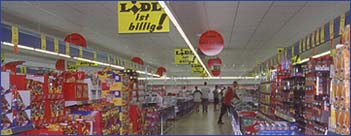7.3 At the supermarket 
 Next, Anna Müller goes to her local Lidl supermarket. Unfortunately, they have just had a refurbishment and moved everything around, such that she has to ask an assistant (die Verkäuferin) where things are. Listen to their conversation by clicking here or on the sound icon at the top of this paragraph. Next, Anna Müller goes to her local Lidl supermarket. Unfortunately, they have just had a refurbishment and moved everything around, such that she has to ask an assistant (die Verkäuferin) where things are. Listen to their conversation by clicking here or on the sound icon at the top of this paragraph.

| Conversation 3: Im Supermarkt |
| Anna Müller |
Entschuldigen Sie bitte. |
| Die Verkäuferin |
Ja, bitte. |
| Anna Müller |
Können Sie mir helfen? |
| Die Verkäuferin |
Was suchen Sie denn? |
| Anna Müller |
Wo gibt's hier denn Milch? |
| Die Verkäuferin |
Milch? Gleich hier vorne links. Bei den Milchprodukten. |
| Anna Müller |
Und wo finde ich Marmelade? |
| Die Verkäuferin |
Ganz hinten im letzten Gang. Im dritten Regal. |
| Anna Müller |
Ich brauche auch noch Kekse. |
| Die Verkäuferin |
Ich glaube, da hinten rechts. |
| Anna Müller |
Und wo ist der Joghurt? |
| Die Verkäuferin |
Im nächsten Gang links. |
| Anna Müller |
Oben oder unten? |
| Die Verkäuferin |
In der Mitte. |
| Anna Müller |
Wo findet man Waschmittel? |
| Die Verkäuferin |
Hier unten, bei den Haushaltswaren. |
| Anna Müller |
Ich suche auch Fisch. |
| Die Verkäuferin |
Im vorletzten Gang, bei der Tiefkühlkost. |
| Anna Müller |
Und Pralinen? |
| Die Verkäuferin |
Tut mir Leid, das weiß ich auch nicht. Fragen Sie doch mal an der Kasse. |
| Anna Müller |
Ich danke Ihnen. |
| Die Verkäuferin |
Nichts zu danken. |
|
| Glossary |
| der Supermarkt |
The supermarket |
| im Supermarkt |
in the supermarket |
| die Verkäuferin (-innen) |
sales assistant (female) |
| ja, bitte |
"Yes" (implying willingness to help) |
| helfen (+ Dative) |
This means "to help". The person whom you are helping is in the dative case in German. |
| können Sie mir helfen? |
can you help me? |
| suchen |
to look for |
| wo gibt es hier...? |
"Where is..?" This is one of many constructions for this phrase which you will find in this section. The object which you are looking for is always in the accusative case in this construction. |
| die Milch |
milk |
| die Milchprodukte |
dairy produce |
| bei den Milchprodukten |
Although "bei" maintains its general meaning of "at" here, we would probably translate this as "amongst the dairy produce" or "in the dairy produce section". Note too that the plural "Milchprodukte" adds an "-n" when in the dative case. The reason for this will be explained later. |
| vorne |
at the front |
| vorne links |
at the front on the left |
| die Marmelade |
No, not marmalade but "jam". The nearest equivalent to British marmalade is "die Orangenmarmelade". Note the slightly different spelling in German too! |
| hinten |
at the back |
| ganz hinten |
right at the back |
| der/die letzte... |
the last... |
der Gang
(pl. - Gänge) |
In a supermarkt, we would translate this by "aisle". It is the general word for a passage, hallway or corridor in a building. |
| das Regal (-e) |
"shelf". Note that while we say "on the third shelf", German uses the equivalent of "in the third shelf". |
| der Keks (-e) |
This means "biscuit, cookie" |
| glauben |
to believe, think |
| der Saft |
(fruit) juice |
| der Apfelsaft |
apple juice |
| das Getränk (-e) |
drink |
| oben |
at the top |
| unten |
at the bottom |
| die Mitte |
middle; centre |
| in der Mitte |
in the middle |
| wo findet man...? |
Note that Anna uses the impersonal "man" form here - it isn't solely used by men! Often, as here, it has the sense of the passive i.e. "Where can this be found?" |
| das Waschmittel |
washing powder |
| hier unten |
down here |
| die Haushaltswaren |
household goods |
| der Fisch (-e) |
fish |
| der/die vorletzte... |
the last but one... |
| die Tiefkühlkost |
frozen food |
| die Pralinen |
chocolates |
| tut mir Leid |
This is short for "das/es tut mir Leid", which we met in Chapter 1 and means "I'm sorry". |
| das weiß ich auch nicht |
I don't know that either |
| fragen |
to ask |
| die Kasse (-n) |
"The checkout". In other contexts you might wish to translate this word by "counter" or "desk". |
| an der Kasse |
at the checkout |
| nichts zu danken |
"don't mention it, you're welcome". Literally: "Nothing to thank for". |
|
 Chapter 7.4: At the checkout Chapter 7.4: At the checkout

 Print This Page Print This Page
|